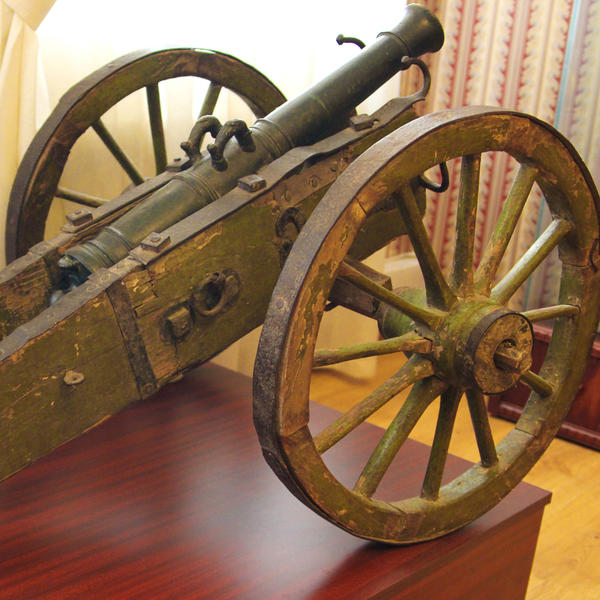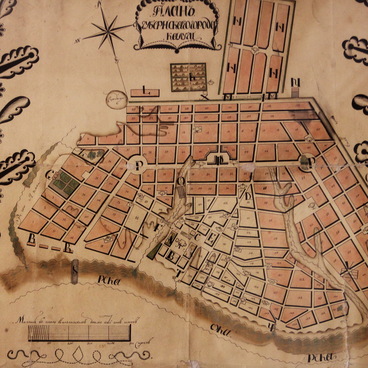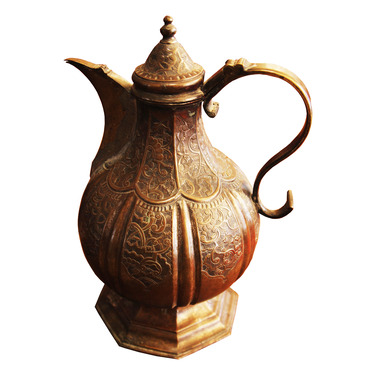The minute gun, alternatively called a signal gun, which makes part of this exhibition, was manufactured in Russia in the second half of the 18th century.
In 1775, Catherine II with her trailing entourage of 20 people visited Kaluga. Her December visit became one of the most prominent events in the historical track record of the city. Data on the Empress’s visit to Kaluga are recorded in the chamber fourrier journal. Such journals contained information regarding all monarch trips, as well as festive ceremonies and high-profile events at the court.
In Kaluga, Catherine the Great was welcomed by ceremonial gun firing arranged with merchant minute guns. According to the testimony of Stephan Ivanov, Kaluga’s priest, once the Empress had left the city, the guns were transferred to St. Nicolas Church for safe-keeping. This stone church was erected after 1775 in place of the former wooden St. Nicolas Church on a hill that provided a good view over the Tula road which was the way taken by Catherine II to enter the city.
Research analysts believe that artillery appeared in Russia in the late 14th century. In the reign of John the Terrible, an English ambassador in his letter to London mentioned that the Russian Tsar had an impressive stock of military ammunition, and the Armoury Chamber had ‘plenty of various types of guns cast of copper which were quite nice’. It was in the times of Ivan the Terrible that Russia launched production of light guns and regimental artillery appeared.
In the early 18th century, Russian artillery was already considered the best in Europe. Dmitry Donskoy was the one to find peaceful application for guns: fireworks were first shot in Russia in 1389. And they became a real trend in the times of Peter I. The first firework devoted to the glory of Russian weaponry took place on December 21, 1709, when the victory at Poltava was celebrated. Since then, salvo firing was an integral part of ceremonies devoted to military victories till the revolution era.
In the Soviet times, such salvo firing tradition was only resumed during the Great Patriotic War. Pursuant to the order of Joseph Stalin, in 1943, a system of celebratory gunfire on the occasion of Soviet army victory was introduced. In post-war years, a tradition of fireworks shooting on the days of national holidays was also established.
In 1775, Catherine II with her trailing entourage of 20 people visited Kaluga. Her December visit became one of the most prominent events in the historical track record of the city. Data on the Empress’s visit to Kaluga are recorded in the chamber fourrier journal. Such journals contained information regarding all monarch trips, as well as festive ceremonies and high-profile events at the court.
In Kaluga, Catherine the Great was welcomed by ceremonial gun firing arranged with merchant minute guns. According to the testimony of Stephan Ivanov, Kaluga’s priest, once the Empress had left the city, the guns were transferred to St. Nicolas Church for safe-keeping. This stone church was erected after 1775 in place of the former wooden St. Nicolas Church on a hill that provided a good view over the Tula road which was the way taken by Catherine II to enter the city.
Research analysts believe that artillery appeared in Russia in the late 14th century. In the reign of John the Terrible, an English ambassador in his letter to London mentioned that the Russian Tsar had an impressive stock of military ammunition, and the Armoury Chamber had ‘plenty of various types of guns cast of copper which were quite nice’. It was in the times of Ivan the Terrible that Russia launched production of light guns and regimental artillery appeared.
In the early 18th century, Russian artillery was already considered the best in Europe. Dmitry Donskoy was the one to find peaceful application for guns: fireworks were first shot in Russia in 1389. And they became a real trend in the times of Peter I. The first firework devoted to the glory of Russian weaponry took place on December 21, 1709, when the victory at Poltava was celebrated. Since then, salvo firing was an integral part of ceremonies devoted to military victories till the revolution era.
In the Soviet times, such salvo firing tradition was only resumed during the Great Patriotic War. Pursuant to the order of Joseph Stalin, in 1943, a system of celebratory gunfire on the occasion of Soviet army victory was introduced. In post-war years, a tradition of fireworks shooting on the days of national holidays was also established.



